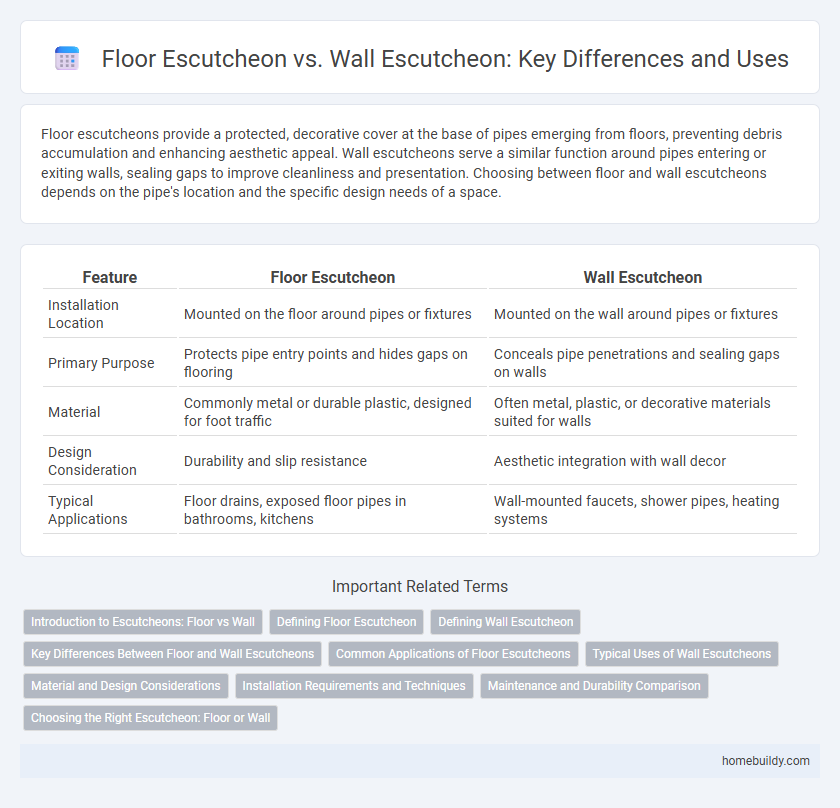Floor escutcheons provide a protected, decorative cover at the base of pipes emerging from floors, preventing debris accumulation and enhancing aesthetic appeal. Wall escutcheons serve a similar function around pipes entering or exiting walls, sealing gaps to improve cleanliness and presentation. Choosing between floor and wall escutcheons depends on the pipe's location and the specific design needs of a space.
Table of Comparison
| Feature | Floor Escutcheon | Wall Escutcheon |
|---|---|---|
| Installation Location | Mounted on the floor around pipes or fixtures | Mounted on the wall around pipes or fixtures |
| Primary Purpose | Protects pipe entry points and hides gaps on flooring | Conceals pipe penetrations and sealing gaps on walls |
| Material | Commonly metal or durable plastic, designed for foot traffic | Often metal, plastic, or decorative materials suited for walls |
| Design Consideration | Durability and slip resistance | Aesthetic integration with wall decor |
| Typical Applications | Floor drains, exposed floor pipes in bathrooms, kitchens | Wall-mounted faucets, shower pipes, heating systems |
Introduction to Escutcheons: Floor vs Wall
Floor escutcheons are designed to cover and protect pipe or cable penetrations through flooring, offering durability against foot traffic and potential impacts. Wall escutcheons provide a neat and functional finish around pipes or fixtures embedded in walls, emphasizing aesthetic integration and ease of access for maintenance. Both types enhance structural integrity and visual appeal in plumbing, HVAC, and electrical installations.
Defining Floor Escutcheon
Floor escutcheons are protective or decorative plates installed around pipes or fixtures emerging from the floor, designed to cover gaps and provide a finished look. Unlike wall escutcheons, which are mounted against walls for similar purposes, floor escutcheons are typically more robust to withstand foot traffic and cleaning activities. These components are essential in plumbing and HVAC systems for both aesthetic appeal and functional sealing at floor penetrations.
Defining Wall Escutcheon
A wall escutcheon is a decorative plate used to conceal pipe penetrations or mounting hardware on vertical surfaces, providing a clean and finished appearance around wall fixtures such as faucets or showerheads. Unlike floor escutcheons, which cover pipe entries through the floor, wall escutcheons are specifically designed to fit flush against walls, often available in various shapes and materials like stainless steel or brass for durability and style. Their primary function is to protect the wall from moisture damage while enhancing the overall aesthetic of plumbing installations.
Key Differences Between Floor and Wall Escutcheons
Floor escutcheons are designed to protect and conceal pipe or cable penetrations on horizontal surfaces, featuring durable materials to withstand foot traffic and prevent debris accumulation. Wall escutcheons, in contrast, are mounted on vertical surfaces to neatly cover plumbing or wiring entry points, offering a sleek finish that enhances aesthetic appeal while preventing dust and pest intrusion. Key differences include their orientation, material robustness suited for floor vs. wall applications, and installation techniques tailored to horizontal non-traffic areas versus vertical visible spaces.
Common Applications of Floor Escutcheons
Floor escutcheons are commonly used to cover and protect pipe penetrations through flooring in residential, commercial, and industrial buildings, preventing debris accumulation and enhancing aesthetic appeal. They are especially prevalent in plumbing installations, heating systems, and HVAC applications where pipes pass through floors. These escutcheons provide a neat finish and help maintain hygienic conditions by sealing gaps around pipes at floor level.
Typical Uses of Wall Escutcheons
Wall escutcheons are typically used to conceal pipe penetrations and provide a clean, finished look around faucets, showerheads, and water supply lines. They help prevent water damage by sealing gaps on the wall surface where plumbing fixtures pass through. These escutcheons are commonly installed in bathrooms and kitchens to enhance both aesthetics and functionality.
Material and Design Considerations
Floor escutcheons are typically made from durable materials like stainless steel, brass, or bronze to withstand foot traffic and resist corrosion, whereas wall escutcheons often utilize lighter metals or plastic composites for easier installation and aesthetic versatility. Design considerations for floor escutcheons emphasize slip resistance and load-bearing capacity, while wall escutcheons prioritize sleek profiles and seamless integration with plumbing fixtures or electrical outlets. Selecting the right material and design ensures both functional performance and complementary visual appeal in various architectural settings.
Installation Requirements and Techniques
Floor escutcheons require precise leveling and secure anchoring to withstand foot traffic and prevent movement, often installed with screws or adhesive designed for flooring materials. Wall escutcheons demand accurate alignment around pipes or fixtures, typically mounted with concealed fasteners or snap-on mechanisms to ensure a clean finish and easy access for maintenance. Both types necessitate careful measurement and fitting to maintain sealing integrity and aesthetic consistency in plumbing or heating installations.
Maintenance and Durability Comparison
Floor escutcheons typically offer higher durability due to their robust construction designed to withstand foot traffic, making maintenance less frequent and simpler. Wall escutcheons require more careful upkeep to prevent damage from moisture and impact, which can compromise their finish and longevity. Choosing between floor and wall escutcheons depends on the specific environmental stressors and maintenance routines tailored to each application.
Choosing the Right Escutcheon: Floor or Wall
Floor escutcheons provide a protective and decorative cover for floor-mounted pipes, offering durability against foot traffic and potential impacts. Wall escutcheons suit pipes emerging from walls, ensuring a clean finish that prevents debris accumulation and enhances aesthetics. Selecting the right escutcheon depends on pipe location, exposure to physical wear, and the desired level of decorative appeal.
Floor Escutcheon vs Wall Escutcheon Infographic

 homebuildy.com
homebuildy.com